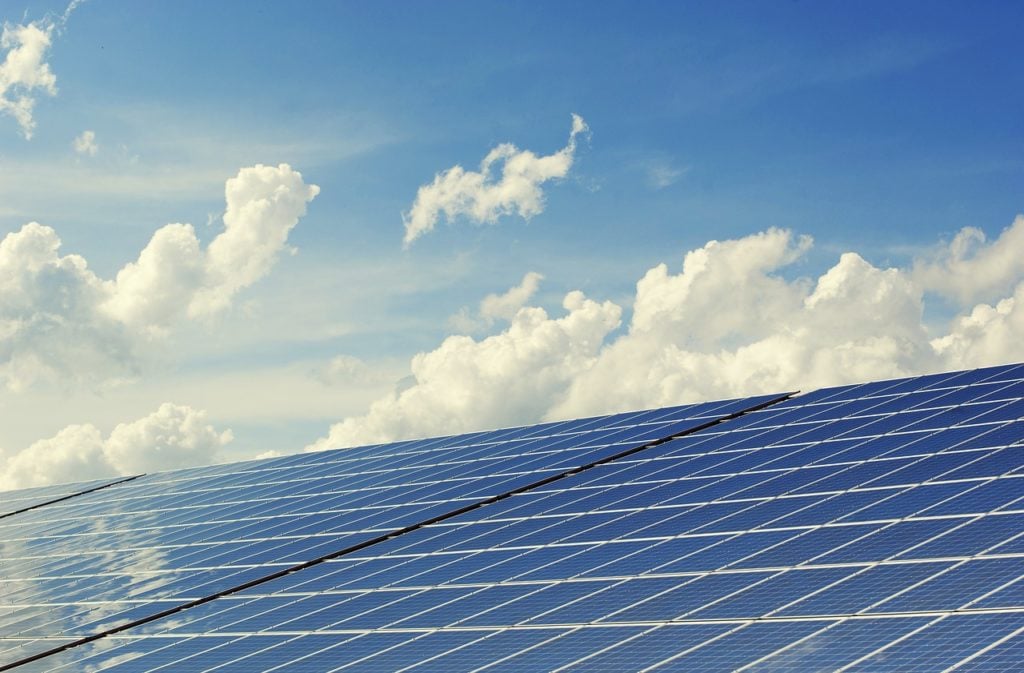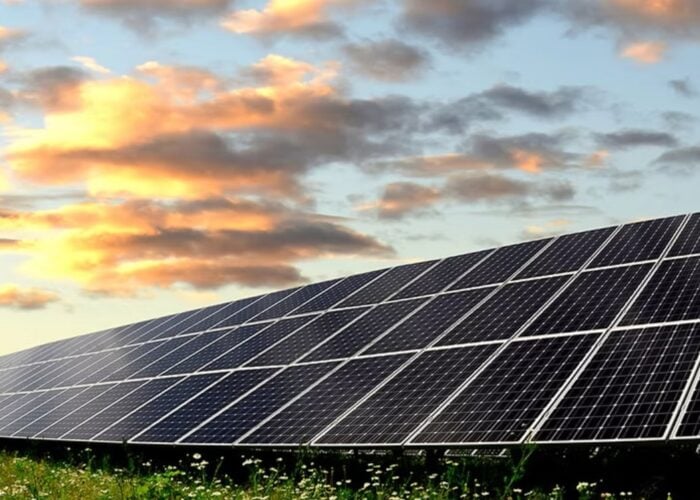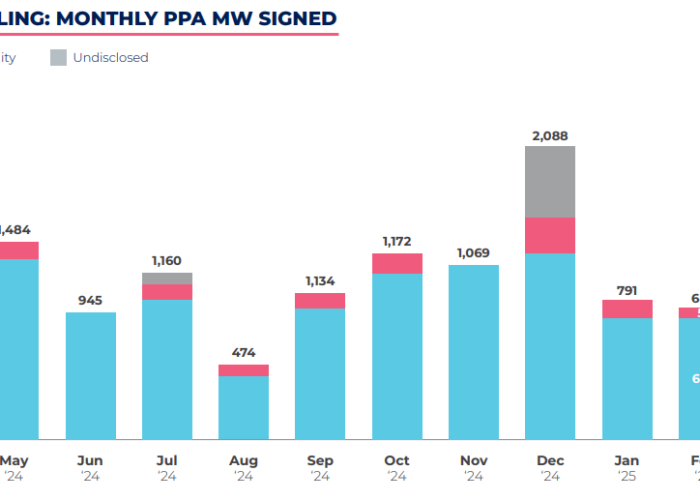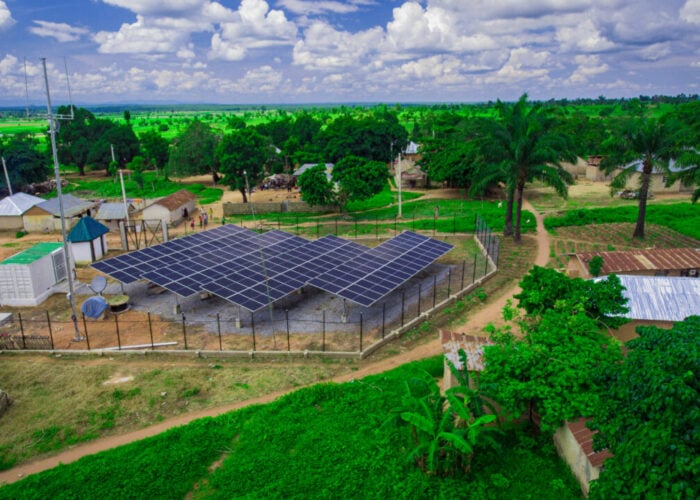
Earlier this year, the Fighting Jays solar project in Texas was battered by “golf ball-sized” hail, an out-of-season weather event that cut into the project’s functionality, and drew attention to the risks associated with developing large-scale solar projects.
While weather damage itself is nothing new in the solar sector – the Fighting Jays incident rekindled questions about the risk of hail damage at solar projects – the widespread surprise at the extent and damage of the hailstorm suggests that this is a risk that has not been fully considered by the solar industry. As the Earth’s climate worsens, out-of-season weather events are more likely to take place, raising the prospect of a greater range of extreme weather incidents that will have to be considered by developers and financiers of solar projects.
Unlock unlimited access for 12 whole months of distinctive global analysis
Photovoltaics International is now included.
- Regular insight and analysis of the industry’s biggest developments
- In-depth interviews with the industry’s leading figures
- Unlimited digital access to the PV Tech Power journal catalogue
- Unlimited digital access to the Photovoltaics International journal catalogue
- Access to more than 1,000 technical papers
- Discounts on Solar Media’s portfolio of events, in-person and virtual
Or continue reading this article for free
In the latest edition of our Big Interview series, we speak to kWh Analytics CEO Jason Kaminsky, whose company manages a comprehensive database of US solar assets, and analyses this data to help assess and minimise project risk. Kaminsky’s own experience in the banking sector puts him in a unique position to assess and discuss the growing risks faced by solar financiers, within the context of increasingly unstable environmental factors.
PV Tech: Why was the destruction at Fighting Jays so striking?
Jason Kaminsky: The thing that made Fighting Jays a little tricky is that, when you look at hail maps, it’s not in the highest hail zone, the highest risk zone. There are two questions any financing party with exposure to these assets is trying to answer: one is, ‘Am I in a bad zone? Am I going to be exposed to the risk?’ and then, ‘if I am, do I have the appropriate mitigation measures in place?’ Historically, from an insurance perspective, less resources have been put into understanding the risks [of hail].
The question is, ‘are we mapping that correctly?’ And are we acting with an appropriate level of care; maybe we’re not in a high hail zone, but we should act like we are.
I think what is probably going to take more time for the industry to really get our arms around is, ‘what was the event that happened? How big was the hail? Was that just, sort of, a tail event, a fluke? Or is that the ‘new normal’? And then what did the project do to help mitigate that event?’
Who is taking on the risk at solar projects?
You can’t just look at a solar asset like any other piece of infrastructure because the technology is changing in subtle but important ways on a pretty regular basis. We’ve actually had quite a lot of innovation as it relates to how these assets interface with this physical hazard risk.
Project finance 101 is identifying risk and allocating risk. The question is, ‘who is the best holder of this risk?’ It used to be insurance companies that say, ‘okay, we’re taking 100% of the risk,’ insurance companies have now said, ‘well, we’re not sure if we want to hold US$500 million of hail risk in a single asset.
A commercial bank has said, ‘that’s not our appetite,’ so it’s become the developer’s risk in some ways, like the developers holding the equity check and they don’t have insurance, they owe a bunch of people a lot of money. So that becomes the question based off the PPA rates or the merchant rates that they’re able to get and what they deem the equity return is needed to hold that level of risk on their balance sheet.
How has risk assessment and management changed over time?
There’s really been a couple of eras, if I break it down, that are self-defined. I don’t think these have been documented anywhere. [There] is pre-2019. That’s when I was doing financing and banking, which was the era of plentiful and cheap insurance. I was negotiating insurance requirements on behalf of the bank.
In the span of four years, I spent maybe cumulatively an hour negotiating and thinking about these provisions. It was just cheap and plentiful, and you could get full limits for what we call ‘nat cat’, natural catastrophe. You’d get full nat cat cover, not an issue.
In 2019, we had our first really significant hail loss, which was Midway, the DE Shaw project. It was a Texas asset with a reasonably significant loss, about US$80 million, and that had some ripple effects through the insurance community because the underwriter, certainly, didn’t expect the potential for that big of a loss. In insurance sometimes you say, ‘I hope I don’t get it, but I know I can have a big loss.’ I think in this case, they didn’t even know the potential was that big. The reason for it was that we began building in Texas and the risks are different in Texas and there wasn’t a lot of data or experience about building solar plants in Texas.
Lo and behold, the hailstorm came, and that did a couple of things. I’ll say some were financial in nature; it changed the financial structure of how the insurance works. Then, it also introduced some new knowledge into the insurance community, which, frankly, we were dealing with in banking ten years prior, but insurance was one step behind.
On the financial side, I call it the correcting market era. This is 2019-2022; you had rate increases – rates probably went up 40-50% a year over that period – and you had much larger deductibles, so the owners of these assets now have to hold very significant deductibles for anything with that kind of exposure.
My perspective is that we’re entering – still pretty early stages, but – the era of resilience. What we mean by that is that right around 2022, we had new research come out from some of the testing labs, module manufacturers and tracking companies that said, ‘Hey, we have ways to mitigate this risk or to build more resilient assets to these risks.’ And that was not knowledge that, as an industry, whether that’s the solar industry or the insurance industry, none of us really had – about how tilt angles of the trackers interface with the loss profile, how the thickness of the glass and the module selection interface with the risk profile [and so on].
Is solar inherently risky? Or perhaps unfairly thought of as risky?
Are these [solar] assets worse than other forms of energy infrastructure? I’d say no. One of the nice things that’s nice about solar is that it’s inherently distributed, so you have lots of farms all over the place, and even if you have one significant event, like the one that we’re all looking at, on the [bigger] scheme of things, it’s a very small event for the industry. When you look at the Texas freeze and some of these other events, the renewables have proven to be incredibly resilient and incredibly reliable.
It’s easy to create a bunch of misinformation, especially in a place like Texas. I feel very strongly we need to do everything we can, as an industry, to try to avoid these losses – it certainly has negative reputational effects and financial effects – but I think the beauty of renewables is that they are distributed and proven to be exceedingly reliable.
Just like bad stuff in any infrastructure anywhere in the US, it just sort of happens; you had flooding in New York and transformers exploding a couple of years ago. It just happened [and] you’ve got to manage through it.
What is the biggest challenge with regard to minimising risk at solar projects?
I think the biggest challenge is operationalising a lot of the insights that we’ve seen, or that we’ve learned. How do you detect that there is a hailstorm coming, and who within your company makes a decision that you’re going to put it into hail stow? And what if that person is on vacation? And what if the grid goes down, can you still communicate with the site?
I’m in touch with some of the folks on the asset management side that would need this and some of these folks spend a lot of their day trying to work through these issues, and they’re like, ‘we did a trial run this year, at just a handful of our sites, [and] we couldn’t communicate with that.’
You have to do annual tests to make sure your procedures are in place and identify which assets are receiving your signals and confirming that they’re going into stow; the list is long! But that, to me, is the challenge that we’re in today – still in probably the first innings of this era of resilience – how to operationalise it, because every asset is unique.






